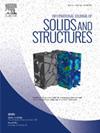面内面外联合荷载作用下砌体墙体强度的数值上限方法
IF 3.4
3区 工程技术
Q1 MECHANICS
International Journal of Solids and Structures
Pub Date : 2025-06-19
DOI:10.1016/j.ijsolstr.2025.113513
引用次数: 0
摘要
本文提出了一种新的屈服设计,基于有限元的方法来确定砌体墙的强度。所提出的方法依赖于Donval等人(2024)最近提出的运行粘结砌体墙的面内面外强度域的半解析上界估计。这种估计是通用的,因为它考虑了砌块和砂浆的有限强度,以及接缝的非零厚度,而无需对结构的应力或应变状态进行任何特定假设。这个估计可以表示为一个二阶锥优化问题。我们建立在这一性质,以导出一个运动学的,基于有限元的屈服设计问题的公式。在描述了有限元实现之后,一些例子突出了该方法的特殊性。特别是,它考虑了膜应力和弯矩之间的耦合,对网格方向的依赖很小,并提供了结构破坏载荷的严格上限。与现有的基于极限分析框架的方法和实验结果进行了比较。本文章由计算机程序翻译,如有差异,请以英文原文为准。
A numerical upper-bound approach to the strength of a masonry wall under combined in-plane and out-of-plane loadings
The present contribution proposes a novel yield design, finite element based approach to determine the strength of a masonry wall. The proposed approach relies on a semi-analytical upper bound estimate of the in-plane and out-of-plane strength domain of a running bond masonry wall, recently proposed by Donval et al. (2024). Such an estimate is versatile, as it accounts for a finite strength for the blocks and the mortar, and a non-zero thickness for the joints, without any specific assumption on the state of stress or strain of the structure. This estimate may be expressed as a second-order cone optimization problem. We build on this property to derive a kinematic, finite element based formulation of the yield design problem. After describing the finite element implementation, some examples highlight the specificities of the approach. In particular, it accounts for the coupling between membrane stresses and bending moments, depends little on the mesh orientation, and provides a rigorous upper bound on the failure load of the structure. Then, the proposed approach is favorably compared to existing methods based on the limit analysis framework and to experiments.
求助全文
通过发布文献求助,成功后即可免费获取论文全文。
去求助
来源期刊
CiteScore
6.70
自引率
8.30%
发文量
405
审稿时长
70 days
期刊介绍:
The International Journal of Solids and Structures has as its objective the publication and dissemination of original research in Mechanics of Solids and Structures as a field of Applied Science and Engineering. It fosters thus the exchange of ideas among workers in different parts of the world and also among workers who emphasize different aspects of the foundations and applications of the field.
Standing as it does at the cross-roads of Materials Science, Life Sciences, Mathematics, Physics and Engineering Design, the Mechanics of Solids and Structures is experiencing considerable growth as a result of recent technological advances. The Journal, by providing an international medium of communication, is encouraging this growth and is encompassing all aspects of the field from the more classical problems of structural analysis to mechanics of solids continually interacting with other media and including fracture, flow, wave propagation, heat transfer, thermal effects in solids, optimum design methods, model analysis, structural topology and numerical techniques. Interest extends to both inorganic and organic solids and structures.

 求助内容:
求助内容: 应助结果提醒方式:
应助结果提醒方式:


